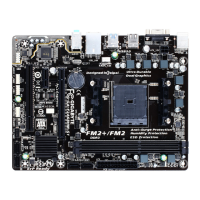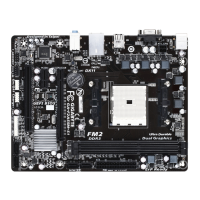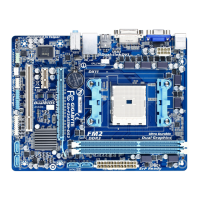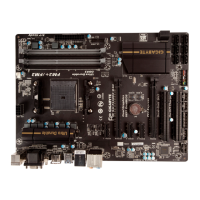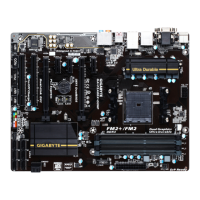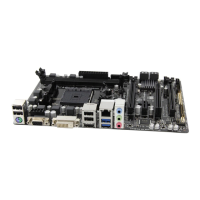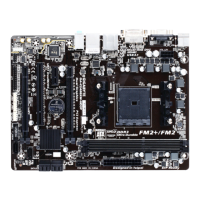
Do you have a question about the Gigabyte GA-F2A68HM-DS2H and is the answer not in the manual?
| Non-ECC | Yes |
|---|---|
| Memory channels | Dual-channel |
| Memory slots type | DIMM |
| Maximum RDIMM memory | 64 GB |
| Number of memory slots | 2 |
| Supported memory types | DDR3-SDRAM |
| Supported memory clock speeds | 1333, 1600, 1866, 2133, 2400 MHz |
| Supported memory module capacities | 2GB, 4GB, 8GB, 16GB |
| Processor socket | Socket FM2+ |
| Processor manufacturer | AMD |
| Compatible processor series | AMD A |
| Maximum number of SMP processors | 1 |
| RAID levels | 0, 1, 10, JBOD |
| Supported storage drive interfaces | SATA III |
| Ethernet interface type | Fast Ethernet, Gigabit Ethernet |
| Cooling type | Passive |
| Component for | PC |
| Power source type | ATX |
| Motherboard chipset | AMD A68H |
| PC health monitoring | CPU, FAN |
| Audio output channels | 7.1 channels |
| Motherboard form factor | micro ATX |
| Windows operating systems supported | Windows 7 Enterprise, Windows 7 Enterprise x64, Windows 7 Home Basic, Windows 7 Home Basic x64, Windows 7 Home Premium, Windows 7 Home Premium x64, Windows 7 Professional, Windows 7 Professional x64, Windows 7 Starter, Windows 7 Starter x64, Windows 7 Ultimate, Windows 7 Ultimate x64, Windows 8, Windows 8 Enterprise, Windows 8 Enterprise x64, Windows 8 Pro, Windows 8 Pro x64, Windows 8 x64, Windows 8.1, Windows 8.1 Enterprise, Windows 8.1 Enterprise x64, Windows 8.1 Pro, Windows 8.1 Pro x64, Windows 8.1 x64, Windows XP Home, Windows XP Professional |
| Number of SATA connectors | 4 |
| USB 3.2 Gen 1 (3.1 Gen 1) connectors | 0 |
| USB 2.0 ports quantity | USB 2.0 ports have a data transmission speed of 480 Mbps, and are backwards compatible with USB 1.1 ports. You can connect all kinds of peripheral devices to them. |
| Maximum resolution | 4096 x 2160 pixels |
| Maximum graphics card memory | 2048 MB |
| Parallel processing technology support | 2-Way SLI |
| BIOS type | UEFI AMI |
| ACPI version | 5.0 |
| BIOS memory size | 16 Mbit |
| Depth | 182 mm |
|---|---|
| Width | 226 mm |
Legal notices regarding copyright, disclaimer, and product information accuracy.
Instructions on how to find the motherboard's revision number for technical reference.
Lists the items included in the motherboard package for reference.
Safety guidelines and procedures before installing the motherboard and components.
Details on APU, Chipset, Memory, Graphics, Audio, LAN, Expansion Slots, Storage, USB.
Lists and locations of all internal headers and connectors on the motherboard.
Step-by-step guide on how to safely install the CPU (APU) onto the motherboard socket.
Instructions for installing RAM modules, including dual-channel configuration.
Guidelines for installing expansion cards like graphics or sound cards into PCI/PCIe slots.
Steps to configure AMD's Dual Graphics technology, including system requirements and BIOS settings.
Details and descriptions of all ports located on the motherboard's rear I/O panel.
Details on ATX power connectors and CPU/System fan headers for system power and cooling.
Connects for front panel buttons, LEDs, audio, USB headers, and S/PDIF output.
SATA connectors for storage and components for battery and CMOS management.
Describes the initial GIGABYTE logo screen displayed during system boot.
Displays current system status for CPU, memory, and voltages.
Allows manual adjustment of CPU base clock, graphics clock, and North Bridge frequency.
Controls CPU performance, AMD Cool&Quiet, SVM (Virtualization), and power-saving modes.
Configures memory timing modes, channel/rank interleaving, and DDR voltage.
Allows manual adjustment of CPU, chipset, and memory voltages for overclocking.
Monitors system voltages, temperatures, fan speeds, and chassis intrusion status.
Controls CPU and system fan speeds based on temperature or manual settings.
Selects BIOS display language and allows manual setting of system date and time.
Displays user access level and prepares for password settings in BIOS.
Configures the boot order of available devices like hard drives, USB, or optical drives.
Sets password protection for system boot or BIOS entry, and manages boot logo display.
Configures boot speed, USB/PS2 device support, and compatibility for legacy/UEFI boot modes.
Sets administrator and user passwords to restrict access and changes to BIOS settings.
Manages AMD IOMMU support and the onboard USB controller functionality.
Enables or disables the onboard HD audio device and the onboard LAN controller.
Configures primary video output, integrated graphics, SATA controllers, and RAID modes.
Configures serial and parallel port settings and their operating modes.
Sets system wake-up events and determines power state after AC power loss.
Configures power button behavior and enables system power-on via keyboard.
Sets system power-on password and enables wake-up via mouse movement.
Options to save changes, exit without saving, or load default BIOS settings.
Guide for setting up SATA controllers and creating RAID arrays with multiple hard drives.
Steps to physically connect SATA hard drives to the motherboard.
Setting the SATA controller mode (RAID, AHCI) within the system BIOS.
Detailed steps for configuring UEFI RAID arrays using a USB flash drive utility.
Commands and examples for creating and deleting RAID arrays using the UEFI RAID utility.
Guide to using the legacy RAID BIOS utility to configure RAID arrays.
Steps to load SATA RAID/AHCI drivers during Windows 8.1/7 and Windows XP installation.
Guide on installing drivers using the motherboard driver disk and Xpress Install utility.
Information on GIGABYTE's environmental compliance and disposal of electronic waste.
Compliance information for FCC (USA) and Industry Canada (IC) regulations for digital devices.
Information on how to contact GIGABYTE for technical support and sales inquiries via eSupport.
